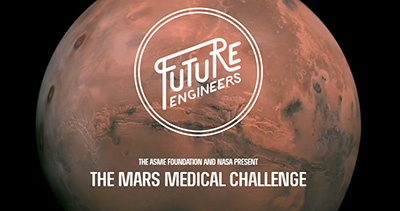Two Students Take Top Honors in Mars Medical Challenge
Two Students Take Top Honors in Mars Medical Challenge
April 7, 2017

Two pre-college students from the West Coast of the United States were recently selected as the winners of the Mars Medical Challenge — the latest in a series of Future Engineers competitions sponsored by the ASME Foundation with technical assistance provided by NASA.
To take part in the Mars Medical Challenge, which was the fifth Challenge offered through the program since its launch in 2014, students in grades K through 12 from across the U.S. were asked to create a digital 3D model of a medical or dental object that could be used by astronauts to maintain their physical health during a three-year mission to Mars. Devices could address a variety of space medical needs, including diagnostic, preventative, first aid, emergency, surgical or dental purposes.
Nearly 750 students from 34 states submitted entries for the latest Challenge in either the Teen Category, for students aged 13 to 19, or the Junior Category, for students aged 5 to 12. The winner in the Teen Category was Lewis Greenstein, an 18-year-old student from Seattle, for his device, the Dual IV/Syringe Pump. The winner in the challenge’s Junior Category was Lauren Lee of Cupertino, Calif., for her entry, the Drug

The device designed by Greenstein, a senior at Seattle Academy, is a pressure infuser that would ensure the flow of intravenous (IV) fluid in microgravity. Greenstein’s Dual IV/Syringe Pump, which was designed to employ materials that would already be found on a spacecraft, features a compartment for an IV bag and another for a blood pressure cuff. As the blood pressure cuff is inflated, the force from the cuff causes the wall between the two compartments to slide, putting pressure against the IV bag and ensuring a steady flow of fluid in a gravity-free environment. The pump is also intended to dispense drugs that need to be administered slowly and precisely through as many as three separate syringes at a time.
Lee, the 12-year-old winner of the Junior Category, designed a 3D printable spring-loaded syringe that astronauts could use to deliver injectable intramuscular drugs, such as epinephrine, during the three-year Mars voyage. The easy-to-use syringe even allows astronauts to self-administer medications, if necessary. Lee said her design was “inspired by many different things, such as oral syringes and ballpoint pens. I started designing by sketching out my thoughts and ideas on paper. Then, I started learning new software programs.”

Deanne Bell, the CEO and founder of Future Engineers, was impressed by the ingenuity and desire to learn that the students, especially Greenstein and Lee, demonstrated during this latest Challenge. “It is inspiring to see these two students use 3D printing to innovate something truly unique in space travel,” Bell said. “This ongoing collaboration between the ASME Foundation and NASA catapults our youth into another realm of science and engineering expertise. I am happy that our platform continues to challenge students to dream big and think off-planet.”
For more information on the Future Engineers 3D Space Challenges, including the full list of Mars Medical Challenge finalists, visit www.FutureEngineers.org. To learn more about ASME’s K-12 education portfolio, contact Patti Jo Snyder, Programs and Philanthropy, by e-mail at snyderp@asme.org.




